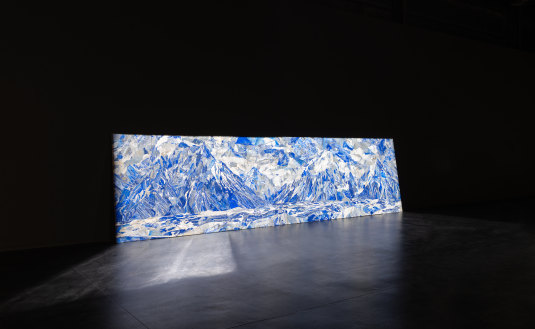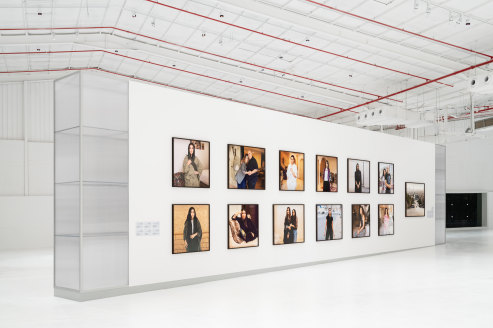
The Diriyah Biennale does justice to the art of the region, so long lacking a showcase, and brings a whole new range of ideas and experiences to an audience with little first-hand experience of contemporary art. One shouldn’t expect radical political statements or riotous sexual content, but there are many works that reflect on climate issues, on Indigenous culture, on war and injustice.
The Saudis may be selling the oil that promotes global warming, but they’re also busy planting 3 billion trees and creating parks and waterways. Like the Chinese, they have decided to live with the contradictions, regardless of the global priorities.

Hamra Abbas’ Mountain 5.Credit: Marco Cappelletti
The curators of the Diriyah Biennale have made a huge effort to reach ordinary Saudis and their families, with displays that aim to educate audiences on the environment and other issues. The earnest intentions are rescued by an engaging display that combines small- and large-scale installations, using darkness and light to create theatrical effects.
If the Biennale works as spectacle, thanks to clever exhibition design, the curators themselves all seem to have studied – or be studying – “curatorship”, which leads to a heavily intellectualised approach. How great it would be if people studied to be art historians again, motivated by a passion for art! Instead, we are producing industry professionals who view art as a research tool to explore social and political problems. It doesn’t mean these students don’t love their subject or show memorable works, but there’s a depressing tendency to choose a paradigm and select items that illustrate it.
It might also be said that too many curators spoil the broth, when some of the very best biennales have been the work of benevolent dictators.
The sheer physical presence of some things cannot be explained away, notably El Anatsui’s installations and environments made from thousands of bottle tops or pieces of shiny foil turned into chain mail. His Logoligi Logarithm was a complete maze in which one wandered through corridors of glittering metal fragments. There may be a point about recycling, but it’s the spatial experience that makes an impression.

Christine Fenzl’s Women of Riyadh.Credit: Marco Cappelletti
So, too, with Kuwaiti artist Hamra Abbas, whose Mountain 5 used slabs of lapis lazuli fastened on granite to create a 10-panel portrait of K2, the world’s second-highest peak. There’s a lot of history and mythology wrapped up in this mountain, and Abbas manages to capture the ferocity with which it has resisted all comers.
There’s at least one large, impressive painting, by Saudi artist Alia Ahmad (b. 1996). In Alwasm she makes her sandy homeland look like nature’s wonderland. Meanwhile, the Polish artist Malgorzata Mirga-Tas has produced a series of colourful portraits of Roma people, constructed from second-hand clothing. The series manages to be both decorative and strangely intimate.
Loading
Another Saudi artist, Abdulrahman Al-Soliman (b. 1954), contributed a suite of ink drawings made in 1990, during the Gulf War, but shown for the first time here. These Palm, Bow and Fragments drawings respond to the flashes in the night sky, but also to palm trees, seen as a symbol of resilience.
There’s a volume of artist films and videos in the show, including substantial pieces such as Yang Fudong’s Blue Kylin (2008) and On the Double Dragon Hills (2012); Liam Young’s futurological saga The Great Endeavor (2023); and Ines Weizman’s absorbing artist documentary about Josephine Baker, “Of all the gin joints in all the towns in all the world …” (2023), told through historical footage and architectural fragments. From the point of view of a local audience they are an entirely novel experience.
One of the simplest and most appealing projects is Christine Fenzl’s Women of Riyadh, a series of photo portraits of young local women, some of them lawyers or doctors. They stare out at us, looking confident in their achievements, the new face of Saudi womanhood. The photographs may be formally unremarkable, but they celebrate a cultural shift of momentous proportions.
They should be contemplated by those who say they will never visit Saudi Arabia because they don’t want to “support” the regime. It could be argued that what visitors are supporting is cultural exchange and an opening-up of attitudes. Let go the preconceptions and one can only feel positive about Riyadh’s efforts to transform itself into a model city for the future.
Diriyah Contemporary Art Biennale: After Rain is at the Diriyah Art Foundation in Riyadh, Saudi Arabia, until May 24. John McDonald flew from Dubai as a guest of the Diriyah Biennale.
To read more from Spectrum, visit our page here.









 Add Category
Add Category